by Calculated Risk on 4/08/2019 11:54:00 AM
Monday, April 08, 2019
AAR: March Rail Carloads down 8.9% YoY, Intermodal Down 1.5% YoY
From the Association of American Railroads (AAR) Rail Time Indicators. Graphs and excerpts reprinted with permission.
We used this phrase a few years ago in Rail Time Indicators, but it’s appropriate again now: sometimes you’re the windshield and sometimes you’re the bug. In March, railroads were the bug. Total U.S. rail carloads in March 2019 were down 8.9% (93,616 carloads) from March 2018. That’s the biggest percentage decline for total carloads for any month since May 2016. … U.S. intermodal originations were down 1.5% (16,387 containers and trailers) in March 2019 from March 2018. Combined with a 0.9% decline in February, this marks the first two-month decline for intermodal since October 2016.
A slowing economy may be having an impact on rail traffic, but bad weather is a more likely culprit. March had bad weather events in many places, but the worst was the horrendous flooding in Nebraska and Iowa caused by melting snow and heavy rain.
emphasis added
 Click on graph for larger image.
Click on graph for larger image.This graph from the Rail Time Indicators report shows U.S. average weekly rail carloads (NSA). Red is 2019.
Rail carloads have been weak over the last decade due to the decline in coal shipments.
In March, just 4 of the 20 carload commodity categories the AAR tracks saw carload gains — the fewest since July 2016. The 8.9% decline in March was the biggest percentage decline for total carloads for any month since May 2016, and follows a 2.7% decline in February. Weekly average total carloads in March 2019 were 239,286, the fourth lowest of any month since sometime prior to 1988, when our data begin.
For the first quarter of 2019, total carloads were down 3.1%, or 100,800 carloads, from the first quarter of 2018. That’s the biggest quarterly decline since the third quarter of 2016.
 The second graph is for intermodal traffic (using intermodal or shipping containers):
The second graph is for intermodal traffic (using intermodal or shipping containers):U.S. intermodal originations were down 1.5% (16,387 containers and trailers) in March 2019 from March 2018. Combined with a 0.9% decline in February, this marks the first two-month decline since October 2016. Weekly average intermodal volume in March 2019 was 266,448 units, the second best for March in history (behind March 2018). For the first quarter, intermodal was down 0.6%.Traffic will likely pick up in April, and there might be some bounce back from the poor weather and flooding.
Las Vegas Real Estate in March: Sales Down 16% YoY, Inventory up 92% YoY
by Calculated Risk on 4/08/2019 09:36:00 AM
This is a key former distressed market to follow since Las Vegas saw the largest price decline, following the housing bubble, of any of the Case-Shiller composite 20 cities.
The Greater Las Vegas Association of Realtors reported Local home prices inch up to $300,000 as homes selling at slower pace; GLVAR housing statistics for March 2019
Local home prices inched back up to the $300,000 mark in March while fewer properties changed hands and more homes were on the market than one year ago. So says a report released Monday by the Greater Las Vegas Association of REALTORS® (GLVAR).1) Overall sales were down 16% year-over-year from 3,886 in March 2018 to 3,260 in March 2019.
...
The total number of existing local homes, condos and townhomes sold during March was 3,260. Compared to one year ago, March sales were down 16.8 percent for homes and down 12.9 percent for condos and townhomes.
...
At the current sales pace, Carpenter said Southern Nevada now has less than a three-month supply of homes available for sale. That’s up sharply from one year ago, but still below what would normally be considered a balanced market. By the end of March, GLVAR reported 7,091 single-family homes listed for sale without any sort of offer. That’s up 84.9 percent from one year ago. For condos and townhomes, the 1,751 properties listed without offers in March represented a 130.1 percent jump from one year ago.
...
The number of so-called distressed sales also continues to drop. GLVAR reported that short sales and foreclosures combined accounted for just 2.5 percent of all existing local property sales in March. That’s down from 2.9 percent of all sales one year ago and from 9.8 percent two years ago.
emphasis added
2) Active inventory (single-family and condos) is up sharply from a year ago, from a total of 4,596 in March 2018 to 8,842 in March 2019. Note: Total inventory was up 92% year-over-year. This is a significant increase in inventory, although smaller than the previous two months, and months-of-supply is still somewhat low.
3) Fewer distressed sales.
Sunday, April 07, 2019
Sunday Night Futures
by Calculated Risk on 4/07/2019 08:14:00 PM
Weekend:
• Schedule for Week of April 7, 2019
Monday:
• No major economic releases scheduled.
From CNBC: Pre-Market Data and Bloomberg futures: S&P 500 are unchanged and DOW futures are up 40 (fair value).
Oil prices were up over the last week with WTI futures at $63.08 per barrel and Brent at $70.34 per barrel. A year ago, WTI was at $63, and Brent was at $68 - so oil prices are mostly unchanged year-over-year.
Here is a graph from Gasbuddy.com for nationwide gasoline prices. Nationally prices are at $2.74 per gallon. A year ago prices were at $2.65 per gallon, so gasoline prices are up 9 cents per gallon year-over-year.
Oil: "A big jump" in Rig Counts
by Calculated Risk on 4/07/2019 11:13:00 AM
A few comments from Steven Kopits of Princeton Energy Advisors LLC on April 5, 2019:
• Oil rigs rebounded sharply, +15 to 831
• Horizontal oil rig counts also saw a nice move up, +8 to 734
• The Permian took all the net horizontal oil rig adds, +8, for the best week in a year
• One might be tempted to call the end of the mini-cycle – again – this week. It certainly could be.
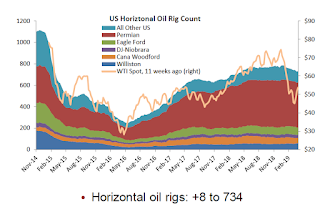 Click on graph for larger image.
Click on graph for larger image.CR note: This graph shows the US horizontal rig count by basin.
Graph and comments Courtesy of Steven Kopits of Princeton Energy Advisors LLC.
Saturday, April 06, 2019
Schedule for Week of April 7, 2019
by Calculated Risk on 4/06/2019 08:11:00 AM
The key report this week is the March CPI.
No major economic releases scheduled.
6:00 AM ET: NFIB Small Business Optimism Index for March.
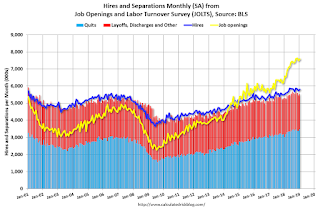 10:00 AM ET: Job Openings and Labor Turnover Survey for February from the BLS.
10:00 AM ET: Job Openings and Labor Turnover Survey for February from the BLS. This graph shows job openings (yellow line), hires (purple), Layoff, Discharges and other (red column), and Quits (light blue column) from the JOLTS.
Jobs openings increased in January to 7.581 million from 7.479 million in December.
The number of job openings (yellow) were up 15% year-over-year, and Quits were also up 15% year-over-year.
7:00 AM ET: The Mortgage Bankers Association (MBA) will release the results for the mortgage purchase applications index.
8:30 AM: The Consumer Price Index for March from the BLS. The consensus is for 0.3% increase in CPI, and a 0.2% increase in core CPI.
2:00 PM: FOMC Minutes, Meeting of March 19-20, 2019
8:30 AM: The initial weekly unemployment claims report will be released. The consensus is for 211 thousand initial claims, up from 202 thousand the previous week.
8:30 AM: The Producer Price Index for March from the BLS. The consensus is for a 0.3% increase in PPI, and a 0.2% increase in core PPI.
10:00 AM: University of Michigan's Consumer sentiment index (Preliminary for April).
Friday, April 05, 2019
BEA: March Vehicles Sales at 17.5 Million SAAR
by Calculated Risk on 4/05/2019 07:55:00 PM
The BEA released their estimate of March vehicle sales. The BEA estimated sales of 17.48 million SAAR in March 2019 (Seasonally Adjusted Annual Rate), up 5.7% from the February sales rate, and up 1.4% from March 2018.
With the strong sales in March, 2019 is averaging 16.9 million (average of seasonally adjusted rate), just behind sales last year (17.0 million average through Q1).
Click on graph for larger image.
This graph shows annual light vehicle sales since 1976. Source: BEA.
Sales for 2018 were the fourth best ever, and the 2019 sales rate is lower than in 2018.
The second graph shows light vehicle sales since the BEA started keeping data in 1967.

A small decline in sales this year isn't a concern - I think sales will move mostly sideways at near record levels.
This means the economic boost from increasing auto sales is over (from the bottom in 2009, auto sales boosted growth every year through 2016).
Public and Private Sector Payroll Jobs During Presidential Terms
by Calculated Risk on 4/05/2019 04:39:00 PM
By request, here is another update of tracking employment during Presidential terms. We frequently use Presidential terms as time markers - we could use Speaker of the House, Fed Chair, or any other marker.
NOTE: Several readers have asked if I could add a lag to these graphs (obviously a new President has zero impact on employment for the month they are elected). But that would open a debate on the proper length of the lag, so I'll just stick to the beginning of each term.
Important: There are many differences between these periods. Overall employment was smaller in the '80s, however the participation rate was increasing in the '80s (younger population and women joining the labor force), and the participation rate is generally declining now. But these graphs give an overview of employment changes.
The first graph shows the change in private sector payroll jobs from when each president took office until the end of their term(s). Presidents Carter and George H.W. Bush only served one term.
Mr. G.W. Bush (red) took office following the bursting of the stock market bubble, and left during the bursting of the housing bubble. Mr. Obama (dark blue) took office during the financial crisis and great recession. There was also a significant recession in the early '80s right after Mr. Reagan (dark red) took office.
There was a recession towards the end of President G.H.W. Bush (light purple) term, and Mr Clinton (light blue) served for eight years without a recession.

The first graph is for private employment only.
Mr. Trump is in Orange (26 months).
The employment recovery during Mr. G.W. Bush's (red) first term was sluggish, and private employment was down 821,000 jobs at the end of his first term. At the end of Mr. Bush's second term, private employment was collapsing, and there were net 382,000 private sector jobs lost during Mr. Bush's two terms.
Private sector employment increased by 20,979,000 under President Clinton (light blue), by 14,714,000 under President Reagan (dark red), 9,039,000 under President Carter (dashed green), 1,511,000 under President G.H.W. Bush (light purple), and 11,890,000 under President Obama (dark blue).
During the first 26 months of Mr. Trump's term, the economy has added 4,912,000 private sector jobs.
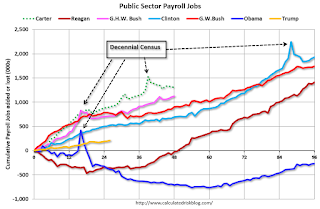
The public sector grew during Mr. Carter's term (up 1,304,000), during Mr. Reagan's terms (up 1,414,000), during Mr. G.H.W. Bush's term (up 1,127,000), during Mr. Clinton's terms (up 1,934,000), and during Mr. G.W. Bush's terms (up 1,744,000 jobs). However the public sector declined significantly while Mr. Obama was in office (down 269,000 jobs).
During the first 26 months of Mr. Trump's term, the economy has added 209,000 public sector jobs.
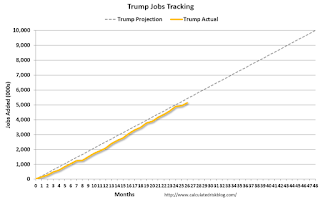
After 26 months of Mr. Trump's presidency, the economy has added 5,121,000 jobs, about 296,000 behind the projection.
Q1 GDP Forecasts: 1.5% to 2.0% Range
by Calculated Risk on 4/05/2019 12:22:00 PM
From Merrill Lynch:
We are tracking 1.9% qoq saar for 1Q GDP growth. Retail sales and capex data this week had little impact on tracking, while strong construction and inventory reports mostly offset consumption weakness at the end of the prior week. [April 5 estimate]From Goldman Sachs:
emphasis added
Our Q1 GDP tracking estimate rose by one tenth to +1.5% (qoq ar). [April 5 estimate]From the NY Fed Nowcasting Report
The New York Fed Staff Nowcast stands at 1.4% for 2019:Q1 and 1.9% for 2019:Q2 [Apr 5 estimate].And from the Altanta Fed: GDPNow
The GDPNow model estimate for real GDP growth (seasonally adjusted annual rate) in the first quarter of 2019 is 2.1 percent on April 2 [Apr 2 estimate]CR Note: These estimates suggest real GDP growth will be in the 1.5% to 2.0% range annualized in Q1.
Comments on March Employment Report
by Calculated Risk on 4/05/2019 10:31:00 AM
The headline jobs number at 196 thousand for March was above consensus expectations of 169 thousand, and the previous two months were revised up 14 thousand, combined. The unemployment rate was unchanged at 3.8%. Overall this was a solid report.
Earlier: March Employment Report: 196,000 Jobs Added, 3.8% Unemployment Rate
In March, the year-over-year employment change was 2.537 million jobs. That is solid year-over-year growth.
Average Hourly Earnings
Wage growth was slightly below expectations. From the BLS:
"In March, average hourly earnings for all employees on private nonfarm payrolls rose by 4 cents to $27.70, following a 10-cent gain in February. Over the past 12 months, average hourly earnings have increased by 3.2 percent."
 This graph is based on “Average Hourly Earnings” from the Current Employment Statistics (CES) (aka "Establishment") monthly employment report. Note: There are also two quarterly sources for earnings data: 1) “Hourly Compensation,” from the BLS’s Productivity and Costs; and 2) the Employment Cost Index which includes wage/salary and benefit compensation.
This graph is based on “Average Hourly Earnings” from the Current Employment Statistics (CES) (aka "Establishment") monthly employment report. Note: There are also two quarterly sources for earnings data: 1) “Hourly Compensation,” from the BLS’s Productivity and Costs; and 2) the Employment Cost Index which includes wage/salary and benefit compensation.The graph shows the nominal year-over-year change in "Average Hourly Earnings" for all private employees. Nominal wage growth was at 3.2% YoY in March.
Wage growth has generally been trending up.
Prime (25 to 54 Years Old) Participation
 Since the overall participation rate has declined due to cyclical (recession) and demographic (aging population, younger people staying in school) reasons, here is the employment-population ratio for the key working age group: 25 to 54 years old.
Since the overall participation rate has declined due to cyclical (recession) and demographic (aging population, younger people staying in school) reasons, here is the employment-population ratio for the key working age group: 25 to 54 years old.In the earlier period the participation rate for this group was trending up as women joined the labor force. Since the early '90s, the participation rate moved more sideways, with a downward drift starting around '00 - and with ups and downs related to the business cycle.
The 25 to 54 participation rate was unchanged in March at 82.5%, and the 25 to 54 employment population ratio was decreased to 79.8%.
Part Time for Economic Reasons
 From the BLS report:
From the BLS report:"The number of persons employed part time for economic reasons (sometimes referred to as involuntary part-time workers) was little changed at 4.5 million in March. These individuals, who would have preferred full-time employment, were working part time because their hours had been reduced or they were unable to find full-time jobs."The number of persons working part time for economic reasons increased in March to 4.499 million from 4.310 million in February. The number of persons working part time for economic reason has been generally trending down.
These workers are included in the alternate measure of labor underutilization (U-6) that was unchanged at 7.3% in March.
Unemployed over 26 Weeks
 This graph shows the number of workers unemployed for 27 weeks or more.
This graph shows the number of workers unemployed for 27 weeks or more. According to the BLS, there are 1.305 million workers who have been unemployed for more than 26 weeks and still want a job. This was up slightly from 1.271 million in February.
Summary:
The headline jobs number was above expectations, and the previous two months were revised up slightly. The headline unemployment rate was unchanged at 3.8%.
This was a solid jobs report, and was probably boosted by some bounce back from the poor weather in February. The economy added 541 thousand jobs in Q1, down from 683 thousand jobs in Q1 2018. So it appears job growth has slowed somewhat, but is still solid.
This was strong enough to alleviate recession fears (no worries!), but not too strong to change the Fed's view of the economy (stay on hold).
Note that sometime soon the overall participation rate will start declining again due to demographic factors. The overall participation rate has been moving sideways for several years, as the expansion has offset the demographics factors.
March Employment Report: 196,000 Jobs Added, 3.8% Unemployment Rate
by Calculated Risk on 4/05/2019 08:42:00 AM
From the BLS:
Total nonfarm payroll employment increased by 196,000 in March, and the unemployment rate was unchanged at 3.8 percent, the U.S. Bureau of Labor Statistics reported today. Notable job gains occurred in health care and in professional and technical services.
...
The change in total nonfarm payroll employment for January was revised up from +311,000 to +312,000, and the change for February was revised up from +20,000 to +33,000. With these revisions, employment gains in January and February combined were 14,000 more than previously reported.
...
In March, average hourly earnings for all employees on private nonfarm payrolls rose by 4 cents to $27.70, following a 10-cent gain in February. Over the past 12 months, average hourly earnings have increased by 3.2 percent.
emphasis added
 Click on graph for larger image.
Click on graph for larger image.The first graph shows the monthly change in payroll jobs, ex-Census (meaning the impact of the decennial Census temporary hires and layoffs is removed - mostly in 2010 - to show the underlying payroll changes).
Total payrolls increased by 196 thousand in March (private payrolls increased 182 thousand).
Payrolls for January and February were revised up 14 thousand combined.
 This graph shows the year-over-year change in total non-farm employment since 1968.
This graph shows the year-over-year change in total non-farm employment since 1968.In March the year-over-year change was 2.537 million jobs.
The third graph shows the employment population ratio and the participation rate.
 The Labor Force Participation Rate declined in March to 63.0%. This is the percentage of the working age population in the labor force. A large portion of the recent decline in the participation rate is due to demographics and long term trends.
The Labor Force Participation Rate declined in March to 63.0%. This is the percentage of the working age population in the labor force. A large portion of the recent decline in the participation rate is due to demographics and long term trends.The Employment-Population ratio declined to 60.6% (black line).
I'll post the 25 to 54 age group employment-population ratio graph later.
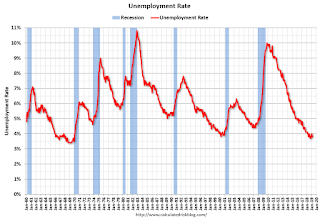 The fourth graph shows the unemployment rate.
The fourth graph shows the unemployment rate. The unemployment rate was unchanged in March at 3.8%.
This was above the consensus expectations of 169,000 jobs added, and January and February were revised up by 14,000 combined. A solid report.
I'll have much more later ...



